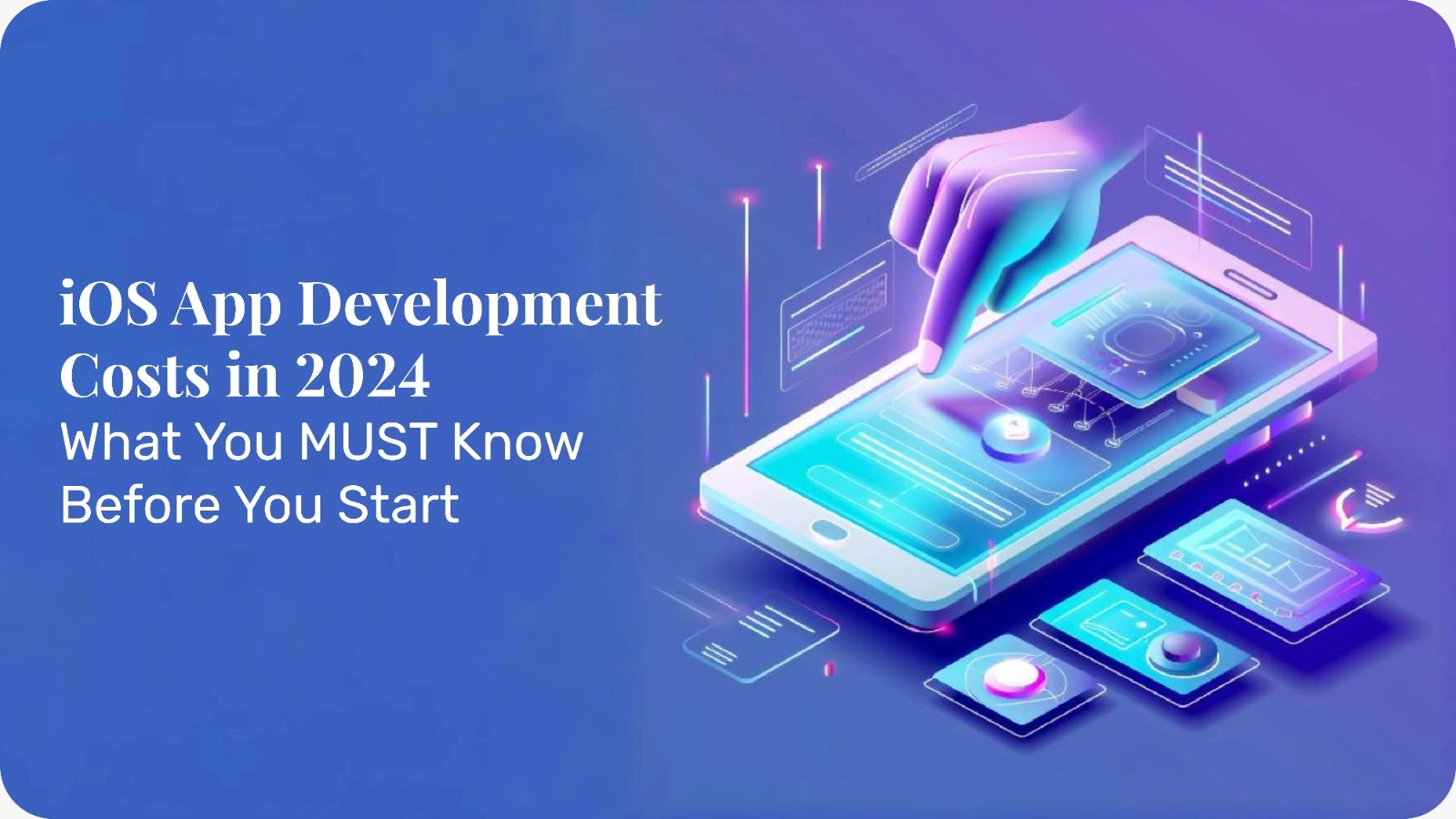
How to Build a Powerful Personal Training App Like Nike Training Club: A 2025 Guide
Continue Reading

Creating an iOS app in 2025 can be really fun and exciting. It also offers great opportunities to be creative and grow your business while showcasing your innovative vision. So, creating an app is a great idea if you are an entrepreneur or an experienced business owner looking to expand your online presence. However, you must have a good understanding of all the iOS app development costs before you start.
That way, regardless of whether you are considering an app with just the essential functions or advanced functions and features, you plan accordingly with knowledge about all the financial aspects associated with the choice you make. So, let’s take a closer look into the essential parts of the iOS app development costs to make sure that you are well-prepared for the journey ahead.
This article breaks down all the iOS app development costs while highlighting some key factors that will affect your financial planning. By the end, you will have a clear idea of what to expect to help you make informed decisions that better align with your vision and available resources.
Breaking down the iOS app development pricing into smaller sections, such as the types of apps based on complexity, their overall features, and the development team you choose, can make it easier to understand. After all, the iPhone app development price can vary significantly based on these features, and knowing about these factors can help you set up a realistic budget that doesn’t surprise you later on down the line.
– Basic Apps: These apps usually have simple features, such as providing information or displaying static pages. They are easy to create and often don’t need much backend support—for example, a basic business app or a simple calculator.
– Medium Apps: Medium apps include features such as user accounts, data fetching APIs, and basic backend support. They may also have social media integration or geolocation features.
– Complex Apps: These apps have advanced features like real-time updates, detailed graphics, or large databases. Examples include online stores and social media platforms.
Getting a fully custom designed can significantly increase your overall costs. However, depending on your requirements, these high costs might be well worth it as a well-designed app not only attracts new users but can also increase engagement. If your app requires a unique user interface (UI) or a specific user experience (UX), you should probably expect to invest more in design. Add in the usually associated design processes such as user testing and adjustments, and your costs can go even higher.
Depending on who you choose to develop your app can also affect your overall budget. This choice is further complicated by the number of vast options available in today’s market. For example you have the option of choosing between freelancers, agencies, or in-house teams to develop your app. However, the price with all of these choices tends to vary by a lot.
Freelancers may be a cheaper choice but quality and reliability are a serious concern with them. Going with an agency would assure you of great quality but then your costs would go up and in-house teams would only be cost effective in the short run when you factor in stuff like salaries and benefits. As such, it is important that you consider your own requirements and budget when choosing amongst the different iOS app development services available.
The overall iOS app development costs can also vary depending on where you are located or outsourcing your app developers from. This can largely be associated with the difference in the value of money based on different countries. For example, a developer in the U.S. may charge a lot more than a developer in Asian countries as labor is usually cheaper over there. It is important to consider the trade-off between cost and quality when choosing a location.
The thing with apps is that just launching them into the market is not enough. They require continuous maintenance and updates so that they can keep running smoothly and keep up with the increasingly competitive world with all technological advancements coming up. As such, post-launch support is vital for any app. However, these regular updates and maintenance also increase your total iOS app development pricing.
But since these costs are essential, it is generally a good rule of thumb to allocate around 15-20% of your initial development cost annually for maintenance. This budget will help you cover any bug fixes, performance improvements while also making sure you can easily adapt to new iOS versions as they come.
It is important that you keep in mind that the actual iOS app development cost varies depending on many different factors such as those detailed above. On average, the cost to develop an iOS app can go anywhere from $15,000.
Here is a more detailed breakdown based on their types as specified above:
| TYPE OF iOS APP | COSTS | |
| 1. | Basic Apps | $15,000 – $40,000 |
| 2. | Medium Apps | $40,000 – $100,000 |
| 3. | Complex Apps | $100,000 and above |
Again, these figures are just estimates and can fluctuate based on specific requirements. It is always best to consult with a development team to get a tailored quote.
Understanding the iOS app development process is crucial to managing costs effectively. Each stage requires time and resources, so knowing what to expect can help streamline your project.
Here is a quick overview of the typical steps involved:
This first stage is about brainstorming your app’s purpose and identifying the target audience. You should clearly define what problems your app will solve and why users would choose it over competitors. Conduct market research to validate your idea. This could involve surveys, focus groups, or studying existing apps in the market. The more information you gather, the better you can refine your concept.
Wireframing is about creating a visual guide that maps out your app’s layout and functionalities. This step helps visualize user journeys and identify potential issues early on. Wireframes can be created using tools like Sketch or Figma and typically include screens and navigational flows. A well-structured wireframe can help save time and resources later on in the development phase.
This phase focuses on UX/UI design. Here you’ll work on creating an appealing and user-friendly interface. This phase usually involves doing multiple modifications and user feedback. Remember, a great design can significantly enhance user engagement and retention. So make sure you pay extra attention to color schemes, typography, and the overall aesthetic, as these elements affect user interaction.
Choose an iOS app development company or team to start building your app. This phase usually follows agile methodologies to ensure flexibility during development. Developers will write code, create the backend, and integrate third-party APIs as necessary. Regular check-ins and updates are essential during this stage to ensure alignment with your vision.
Testing is a critical phase that ensures quality. Conduct thorough testing to identify bugs and ensure the app functions as intended. Focus on usability, performance, and security. User acceptance testing (UAT) is crucial, allowing real users to provide feedback before launch. This stage helps catch issues early, which can reduce the total iPhone app development cost in the long run.
Launching your app on the App Store requires preparation. Make sure all documentation is in place and that your app meets Apple’s guidelines. Prepare for user feedback and potential updates. A successful launch includes a marketing strategy to create buzz around your app and drive initial downloads.
Regularly update your app for improvements and new features. Allocate a budget for ongoing support. Post-launch maintenance is crucial for keeping your app relevant. This includes fixing bugs, updating for new iOS versions, and incorporating user feedback into future updates.
The timeline for developing an iOS app can vary widely depending on several factors. Here is a rough estimate based on app complexity, helping you gauge how long your project might take:
| TYPE OF iOS APP | TIME ESTIMATE | |
| 1. | Basic Apps | 1-3 months |
| 2. | Medium Apps | 3-7 months |
| 3. | Complex Apps | 6-12 months or more |
Again, these timelines depend on your chosen team’s efficiency, the overall project scope, and any unforeseen challenges. So you should always factor in some extra time for unexpected delays.
Before embarking on your iOS app development journey, consider these critical factors to ensure success:
Set a realistic budget that includes initial development and ongoing maintenance costs. Understand that unexpected expenses may arise, so having a cushion can be beneficial. Break down your budget into categories such as design, development, testing, and marketing.
Research companies thoroughly to find the best fit for your project. Look for reviews, past projects, and expertise in your app’s niche. Don’t hesitate to reach out for initial consultations to gauge their understanding of your requirements.
Know who your users are and tailor your app’s features to meet their needs. Understanding your audience will help you design a user-friendly app that resonates with them. This research phase is crucial for shaping your app’s functionalities and marketing strategy.
Plan your marketing before launch to maximize your app’s visibility. Create a buzz around your app through social media, blogs, and influencer partnerships. Consider pre-launch campaigns to generate interest and gather early feedback.
Ensure compliance with Apple’s guidelines for app submissions. This includes understanding copyright, privacy laws, and data protection regulations. Consulting with legal experts can save you from potential issues down the road.
When calculating the cost of developing an iOS app, remember to account for hidden expenses. Here is what to look out for to avoid surprises:
– App Store Fees: Apple charges an annual fee for hosting your app, typically around $99 for the Apple Developer Program. This cost is recurring and should be part of your budget.
– Licensing Fees: If using third-party APIs or services, factor in licensing fees. These can add up, especially if your app relies heavily on external data or functionalities.
– Marketing Costs: Allocate a budget for promoting your app. Effective marketing strategies can significantly boost your app’s downloads and user engagement.
– Legal Fees: Ensure your app complies with all regulations to avoid legal troubles. This might include hiring legal experts to review your app’s terms of use and privacy policy.
Choosing the right iOS app development company can make or break your project. Here are some tips to guide your selection process:
Look for companies with a solid portfolio that showcases their work. A diverse portfolio indicates versatility and expertise in various app types and industries.
Read reviews and case studies to gauge client satisfaction. Reach out to past clients for feedback on their experiences. This information can provide insight into the company’s reliability and quality of work.
Ensure the development team has skills in the latest iOS technologies. Knowledge of relevant frameworks is essential. Ask about their development processes and how they stay updated with industry trends.
Choose a team that communicates effectively. Regular updates and feedback loops are vital for project success. A good communication strategy helps prevent misunderstandings and keeps the project aligned with your vision.
Ensure they offer maintenance services after the app goes live. A good support plan can save you money in the long run, as it helps address issues quickly and implement updates as needed.

Understanding iOS app development costs in 2025 is essential for creating a successful app. By taking note of the factors that influence pricing, the development process, and hidden expenses, you’ll be better prepared to navigate the complexities of app development. Take the time to plan, budget, and choose the right development partner.